How to Install a Branched-Drain Greywater System in a Green Home
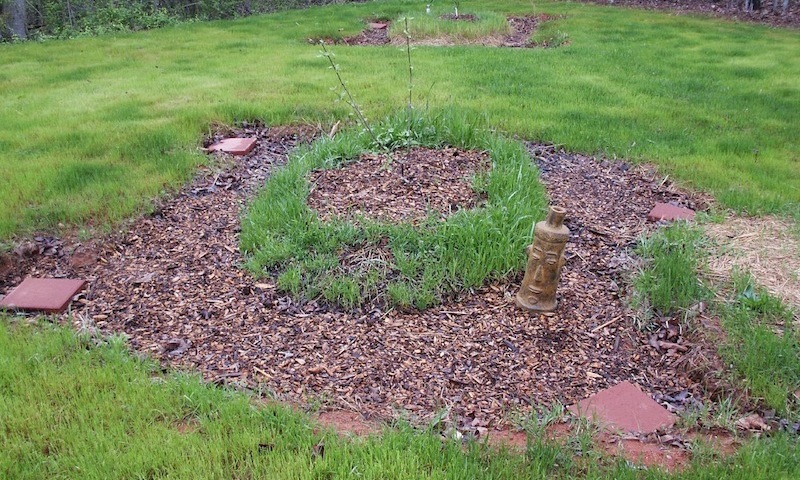
Back in the summer of 2003, I was finishing up the green home I’d started building in 2001. One of the last pieces we had to complete was the greywater system, and we’d already put a lot of work into it before we ever moved a spadeful of dirt.
Even before my (now ex-) wife and I bought the land and started planning our house, we knew that we wanted to build as green a home as possible. Energy efficiency was essential, of course, but so were using low-impact materials and treating wastewater in a way that would create the least disturbance to the environment.
Sewer wasn’t an option, and we didn’t want a septic tank. I’d been fascinated by composting toilets for a long time and definitely wanted one in our home, so that made it possible to install a greywater system to handle the rest of our wastewater. I don’t remember how long it took or how we found him, but somehow in the summer of 2001, we discovered Art Ludwig and his company, Oasis Design.
We pored over Art’s books and settled on the branched-drain greywater system. Our next step was to get it permitted, so we wrote up a detailed proposal describing the rationale, our site characteristics, the numbers, and the design. (You can download the greywater proposal here.)
Briefly, a branched-drain greywater system divides the flow into smaller and smaller branches. In our design, the greywater was divided four times between the main pipe from the house and any of the 16 outlets, all of which discharged the greywater below the surface. The greywater was split into two equal amounts at each junction by the use of special plumbing tees called double ells (photo below).
We got our permit in the fall of 2001 but left installation of the greywater system till the end. In an article for the Southface Journal in 2004, I wrote a little about the permit snafu this delay caused but can’t seem to locate my pdf copy of the article right now. As soon as I do, I’ll make it available for download as well. It was an interesting journey, from permit, to rejection, to permit again.
OK, fast forward to 2003 again now. We started the greywater system installation by laying the pipe out on the properly graded back yard, as you see below.
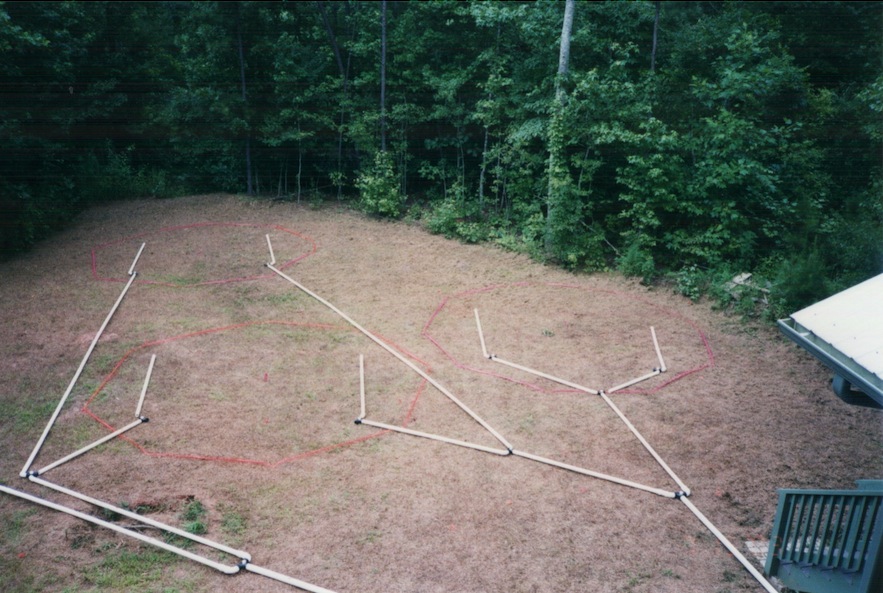
Next, I rented a Ditch Witch to cut the trenches for the pipes.
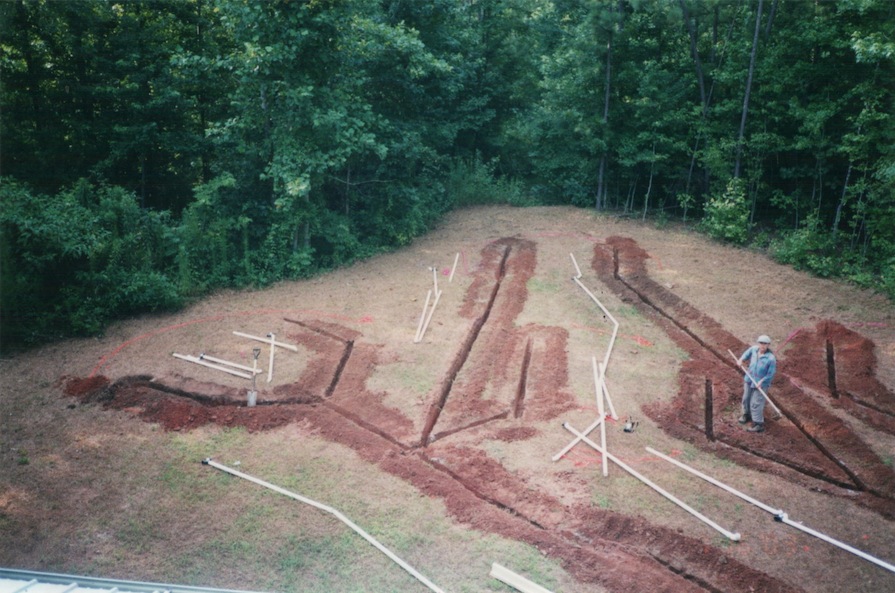
Once the trenches were finished, we took on the more difficult job of digging out the mulch basins and laying the pipe. (Don’t you just love that red Georgia clay!)
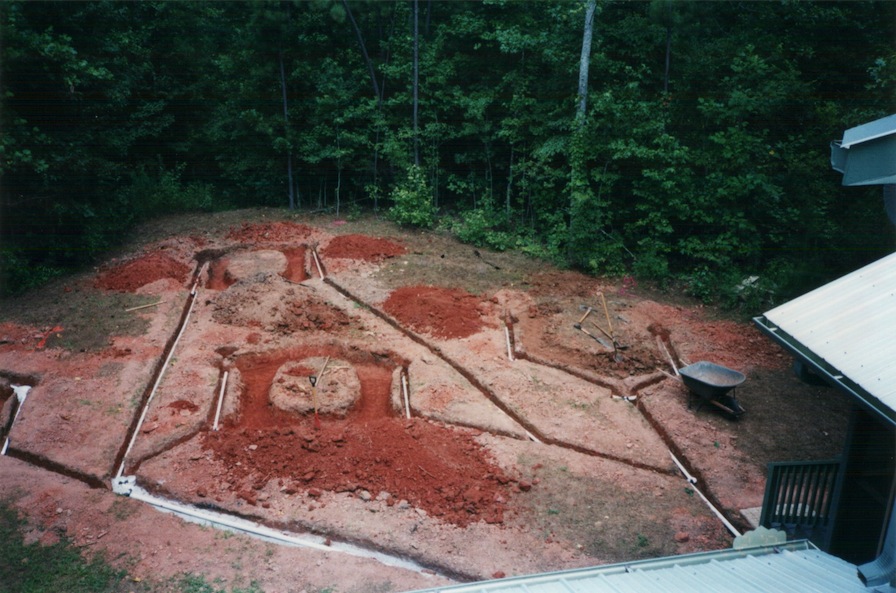
With all the pieces installed, we then filled the moat-like mulch basins with shredded pieces of old rubber tires, bits of asphalt, and dead alkaline batteries. Ha! Just kidding. We were boring (and sane) and put mulch in the mulch basins.
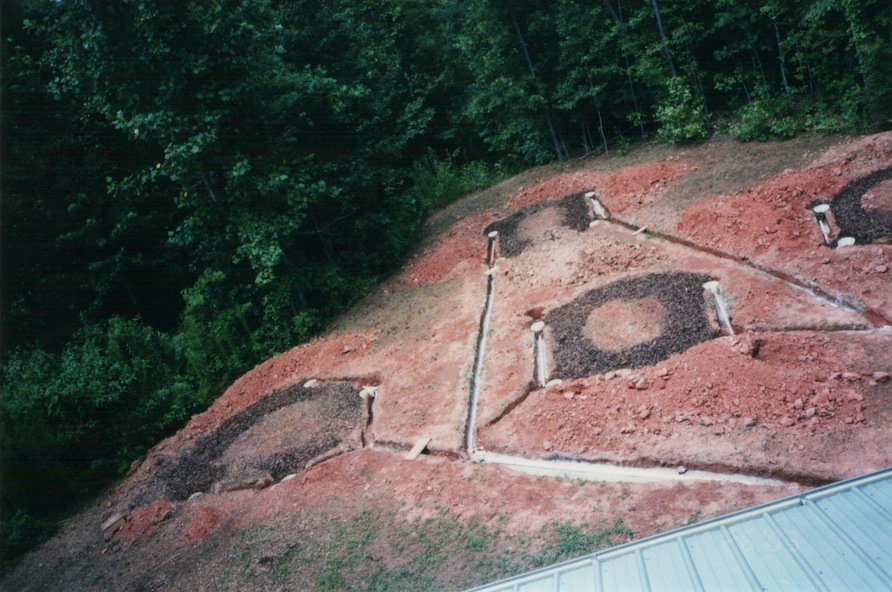
Below you see the main pipe coming out of the house and hitting the first branching junction. In this case, the junction was a valve because we divided the whole system into two zones, which we used alternately, allowing each zone to dry out for a couple of weeks while the other zone was in use. I also installed cleanouts at the top of each zone and intentionally placed them near a downspout so we could flush each zone with rainwater occasionally, too.
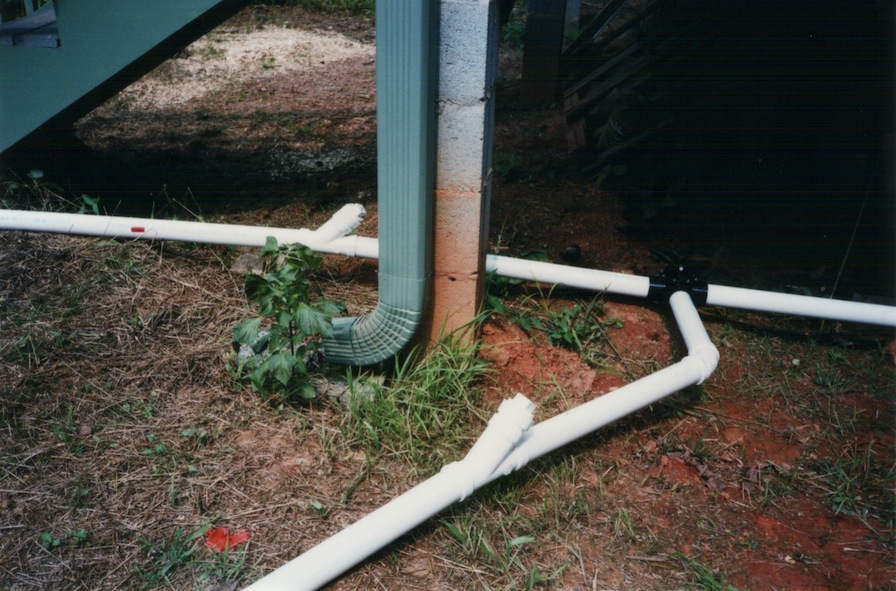
The photo below shows a closeup of a double ell divider (with another nearby). I also used a few bags of builder’s sand to keep the proper slope on the pipes so water wouldn’t hang out in low spots.
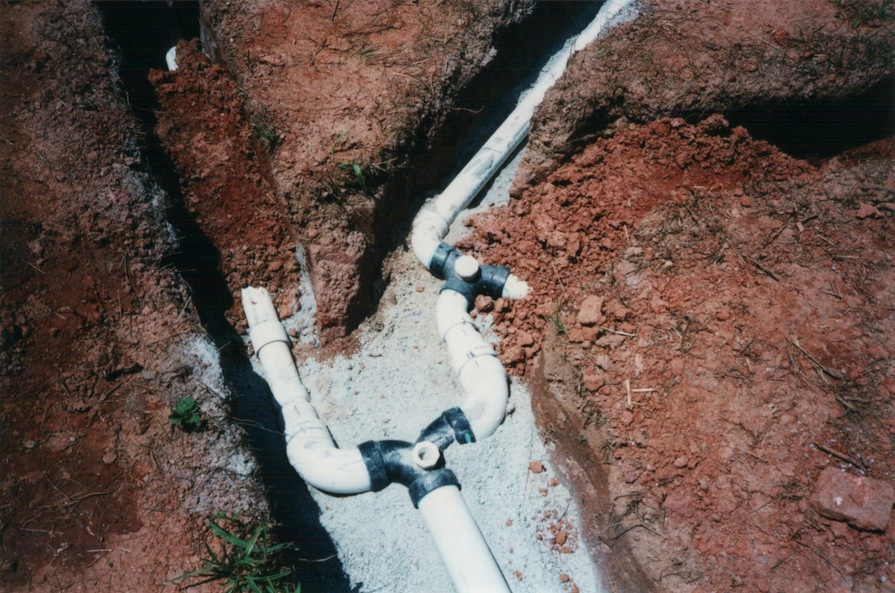
The outlets were drywall mud buckets with the bottom cut out, a lot of holes drilled in the sides, and buried in the mulch basins. I put pea gravel in the bottom of each bucket and a paver stone on the open top. The pavers, which you can see in the first photo at the beginning of this article, allowed for easy inspection.
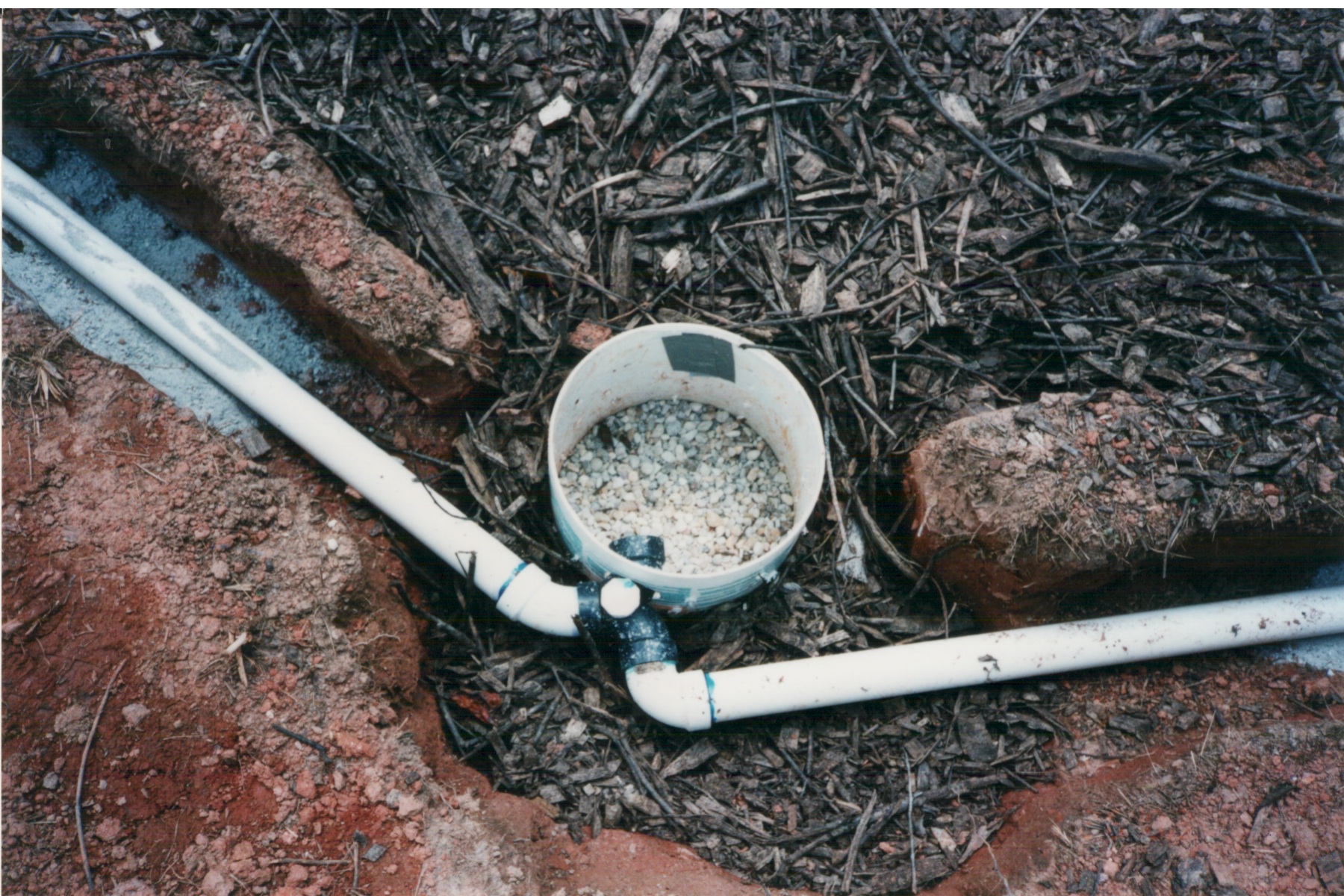
In the winter after we installed the greywater system, we planted trees in the center of each mulch basin. We did some research on good fruit trees for this application and ended up deciding on two cornelian cherry trees and two mayhaw trees, which we bought from Hidden Springs Nursery in Cookeville, TN. The one you see below is one of the cornelian cherries, a type of dogwood.
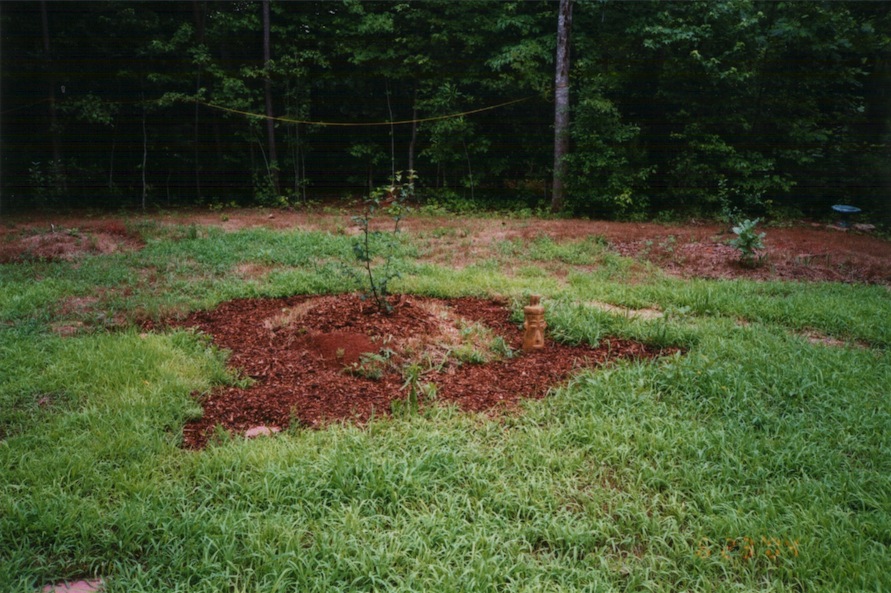
All the photos above were taken in 2003-04. In 2008, I got on the roof one last time to take some photos showing how things had grown, and you can see that the trees look quite happy, even though they’d just lived through three summers of drought.
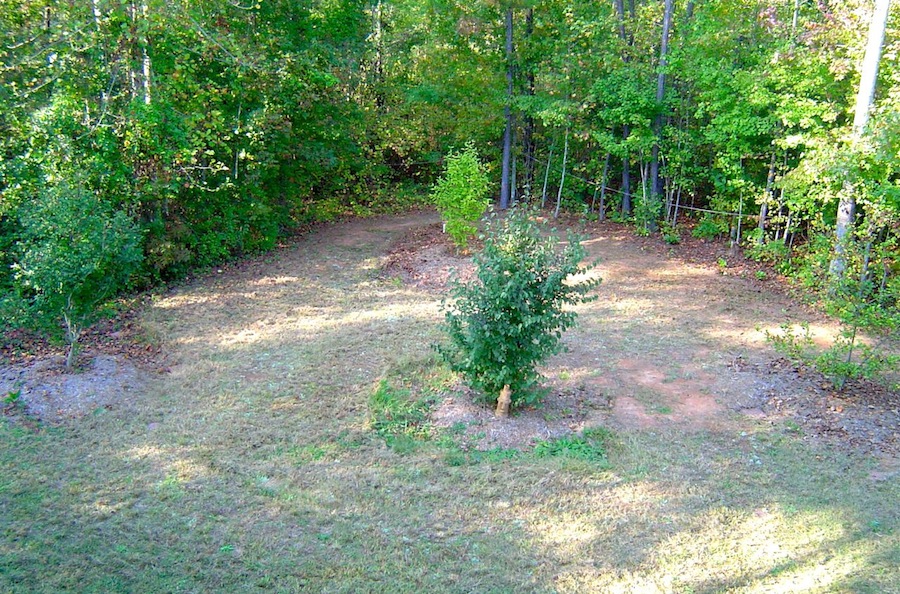
In the three years I lived in the house, the greywater system performed perfectly. There was nary a clog or a smell or any problem at all. And with no pumps, filters, or tanks, there was no maintenance to speak of. All we really had to do was switch the zone valve every two or three weeks and add mulch periodically.
What was more work than the minimal maintenance was the carrying out the research project on how the greywater system affected the groundwater quality and filing the quarterly reports with the state since we got it approved as an experimental system.
Alas, I think the couple who bought the house last year were planning to install a septic tank. I don’t know if I’ll ever be able to bear going back and seeing what’s happened there. I still have my memories, though, as well as the knowledge and experience I gained and the transformation that happened within as a result of being so deeply involved with the whole process of birthing a green home.
Download the Branched-Drain Greywater System Proposal that I submitted to get the system described above permitted and installed.
Allison A. Bailes III, PhD is a speaker, writer, building science consultant, and the founder of Energy Vanguard in Decatur, Georgia. He has a doctorate in physics and writes the Energy Vanguard Blog. He is also writing a book on building science. You can follow him on Twitter at @EnergyVanguard.
Related Articles
Won’t That Stink? — Living in a Green Home with a Composting Toilet
How I Learned to Count by Building a Green Home
Building Your First House as an Owner-Builder
Comments are closed
This Post Has 8 Comments
Comments are closed.

Great piece. It is good to
Great piece. It is good to get a nice shift into other green technologies other than “energy” work. Looks like a good system.
Thanks Bro. An interesting
Thanks Bro. An interesting read, the pictures make it very helpful to understand the process. I am considering this type of system when I’m ready to build in Texas one day. I just hope the State will be open to permiting!
Why is it that nobody does
Why is it that nobody does biogas generators? I just looked at a house that was off-grid and has a 4 panel solar PV system for summer and a microhydro system for winter. But the bulk of the energy comes from a propane tank. The stove and refrigerator are both propane fired. The builder put in a septic tank. He could have put in a biogas digester and gone completely carbon free.
Christopher
Christopher: Thanks. Yeah, I have to write about something besides building envelopes and HVAC every once in a while.
Ken: The permitting process can be interesting. It might go smoothly if you get the right people to deal with, or it might become nearly impossible.
jak: I’d love to see more biogas digesters out there. It’s a great way to get rid of organic waste, even stuff that you can’t (or don’t want to) put in a compost pile, and it gives you fuel.
Allison,
Allison,
The only reservation I’d have about a general greywater distribution system like this one is that it seems fine to me only if you’re a vegetarian household.
On the other hand, discharging dishwater into the ground that contains animal fat residue (when your family consists of carnivores) is problematic, for the same reason you’re ill-advised to compost animal fat: Because animal fat contains certain pathogens that remain in the soil, and are not good for your plantings.
So was just wondering if you had any opinions on that, or had considered that when you were doing your research. Otherwise, the physical design of your system looks great!
~John
How deep were your mulch beds
How deep were your mulch beds? Did you have any calculations you used to decide how many feet of pipe/buckets/depth of mulch beds you would need based on the amount of expected outflow?
Daniel: If
Daniel: If you click the link at the end of the article, you can download the proposal I submitted. You should find a lot of your questions answered there.
John,
John,
A grey water system like that is fine for meat eaters too. This is something that I’ve been experimenting with. I’m no vegetarian but there is very little animal fat getting washed down my drains. In fact, there is very little soap or any kind of food residue that gets washed down my drains. As a Nutritionist who is very skilled in chemistry, I’ve been able to adjust my household food production and dishwashing practices to make all that a non-issue. You could learn to do the same too. So, if animal fats in your dishwater is a concern, my response built from my personal experience is that a lifestyle change is in order rather than a plumbing change. Something to think about. Anyone can take a perfectly sustainable solution and make it not work by abusing it. BTW: no my animal fats are not getting tossed out in the trash either. I eat it ALL!